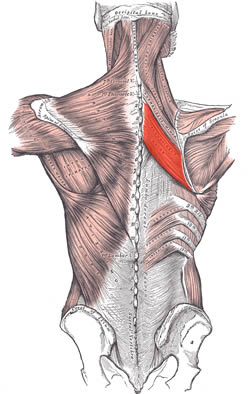The rhomboid major muscle is found in the posterior aspect of the thorax between the spine and scapula. This muscle originates from the spinous processes of the thoracic vertebrae T2 to T5 as well as the supraspinous ligament at these levels by way of an aponeurosis that varies in width. It inserts on the medial border of the scapula, from about the level of the scapular spine to the inferior angle of the scapula by way of short tendinous fibers.
It adducts, elevates, and inferiorly rotates the scapula. It also helps to maintain the scapula flush with the posterior aspect of the thoracic cage. It is innervated by the dorsal scapular nerve (C4, C5), a branch of the brachial plexus.
The Terminologia Anatomica name for the muscle is musculus rhomboideus major.
The rhomboid major is one of the 17 muscles that attach to the scapula.
Sources:
1. “Gray’s Anatomy” Henry Gray, 1918
2. "Tratado de Anatomia Humana" Testut et Latarjet 8th Ed. 1931 Salvat Editores, Spain
3. "Gray's Anatomy" 38th British Ed. Churchill Livingstone 1995
4. “An Illustrated Atlas of the Skeletal Muscles” Bowden, B. 4th Ed. Morton Publishing. 2015
5. "Morris' Human Anatomy" Pearce, J. (1942) Blakiston Co. Philadlephia USA
6. "Trail Guide to The Body" 4th. Ed. Biel, A. Books of Discovery. 2010
Image modified from the original by Henry VanDyke Carter, MD. in the book "Grays's Anatomy" by Henry Gray FRS. Public domain




